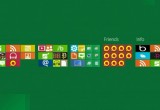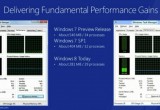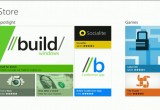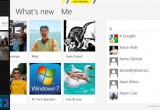Windows 8 Features: Answers To All Your Questions and What PCs Will Be Compatible
Online, July 23, 2012 (Newswire.com) - Microsoft's "re-imagining" of Windows 8 is focused very heavily on a new, Metro-style touch-based interface. However, they make a big deal of saying that it is just as usable with a mouse and keyboard-and no matter what device you're on, you can switch between the simple Metro interface and the traditional Windows desktop to fit whatever your needs are at that given moment.
Please call iComputer with any questions: http://icomputerdenver.com
Performance Increases
One of the issues that have been a concern with the new interface was if it would bog Windows down with more running processes, and whether running a full Windows desktop on a low-powered tablet was really a good idea.
Microsoft has addressed these issues: Windows 8 is supposed to have better performance than Windows 7, even with this metro interface running on top of a desktop.
Tablet users and netbook users especially should notice a fairly significant performance increase with Windows 8. Microsoft has engineered Windows 8 to suspend your tablet-based apps when you jump into the traditional desktop, so they don't take up any of your resources.
The Home Screen
The home screen is very familiar to anyone who's used Windows Phone. You've got a set of tiles, each of which represents an application, and many of which show information and notifications that correspond to the app. For example, your email tile will tell you how many unread emails you have (and who they're from), your calendar tile will show upcoming events, your music tile will show you what's playing, and so on. You can also create tiles for games, contacts, and even traditional Windows apps that will pull you into the Windows desktop.
Running Apps
Running a basic app works as you expect-you tap on its home screen icon and it goes full screen. The browser has lots of touch-based controls, like pinch to zoom and copy and paste, and you can access options like search, share, and settings through the Charms bar, which you can get by swiping from the right edge of the screen or pressing Win+C. Apps can share information one another easily, such as selected text or photos. After picking your media from one app, you'll then be able to choose which app you want to share with, and work with it from there. For example, you can share photos to Facebook, send text from a web page in an email, and so on.
None of this is brand new to touch-based platforms, but what is new is the ability to not only multi-task, but run these apps side by side. Say you want to watch a video and keep an eye on your news feed at the same time. Just like in Windows 7 for the desktop, you can dock an app to one side of the screen while docking another app at the opposite side. This feature allows you to ignore the full desktop interface more often and stay in the touch-friendly, tablet view.
The Windows Store
The Windows Store, which is now available in the Consumer Preview, looks much like the home screen, with tiles that correspond to different categories and featured apps. From there, you can look at a more detailed list of the available apps in a given section. And, the store contains not only touch-based apps for the tablet interface, but some of the more traditional desktop Windows apps you're used to, so you have one portal to discover all your Windows apps no matter what interface you're using.
Right now, the Windows Store is full of free apps from Microsoft and its partners, so you can check out some of the upcoming apps now. When Windows 8 officially releases to the public, though, you should find many more apps in the store, including paid ones. What's really cool about the app store is that you can try apps before you buy, and then download the full version without losing your place in the app or reinstalling anything.
Sync All Your Data to the Cloud
The cloud is taking center stage, with your Microsoft account driving all the syncing in Windows 8. Your address book, photos, SkyDrive data, and even data within third-party apps can sync up to the cloud, and you can access them on any Windows 8 device-even a brand new one. Just sign in, and you'll have access to everything (not unlike Chrome OS, which immediately loaded your themes and extensions when you logged in-great for lending your computer to a friend). The address book also syncs with other services like Facebook and Twitter as well. You can even sync all of your settings from one Windows 8 PC to another. Just sign onto your Windows 8 with a Microsoft account and you'll get all your themes, languages, app settings, taskbar, and other preferences will show right up. It's a pretty neat feature if you have multiple Windows 8 PCs and don't want to set them all up separately.
The Desktop
The traditional desktop is still there, though it may be a little different than what you're used to. First, there's no start button. Your taskbar merely shows the apps you have pinned, with your system tray on the right, as usual. You can jump back to the start screen (that is, the Metro screen) by pressing the Windows key or by moving your mouse to the bottom left corner of the screen. Other than that, everything looks pretty similar (though the windows no longer have rounded corners). The Control Panel has been updated a bit, as well as the Task Manager and Windows Explorer, which we'll discuss below.
A New Task Manager
Microsoft's finally redesigned the task manager, and it looks pretty great. You have a very simple task manager for basic task killing, but if you're a more advanced user, you can bring up the detailed task manager filled with information on CPU and RAM usage, Metro app history, and even startup tweaking-so you can get rid of apps that launch on startup without going all the way into msconfig.
Windows Explorer
They didn't show us a super in-depth look at the new Windows Explorer, but we did get a little peek. Most of it isn't new information: Windows 8 Supports Native ISO Mounting, a new Office-style ribbon, and a one folder up button found in older versions of Windows Explorer. It also has a "quick access" toolbar in the left-hand corner of the title bar, giving you quick access to your favorite buttons from the ribbon.
One of the most common complaints about the Explorer interface in Windows 7 was that it dumped the 'up' button used to move up in the directory structure. The good news is that it's returning in Windows 8. Microsoft will achieve that by using the Ribbon interface.
On the surface, the ribbon looks inconsistent with the tile-based, Windows Phone-style design and fonts that Microsoft has adopted for the default Start screen in Windows 8. Microsoft will be giving more details on Windows 8 in the near future, and it will be interesting to see how the company bridges the new and old elements of the overall Windows interface.
Other Features
Along with these cool features, Windows 8 also comes with other features we've become familiar with in our mobile OSes. It has a system-wide spellcheck, so you don't have to rely on a specific app to keep your spelling correct, as well as a system-wide search feature, that lets you search anything from your music library to your contacts to the web itself. It also has a feature for desktop users that lets your run the Metro UI on one monitor while running the traditional desktop on the other.
Windows 8 Requirements
Windows 8 Consumer Preview should run on the same hardware that powers Windows 7 today. In general, you can expect Windows 8 Consumer Preview to run on a PC with the following:
1 GHz or faster processor
1 GB RAM (32-bit) or 2 GB RAM (64-bit)
16 GB available hard disk space (32-bit) or 20 GB (64-bit)
DirectX 9 graphics device with WDDM 1.0 or higher driver
1024 x 768 minimum screen resolution
However, there are some additional requirements to take into consideration in order to use certain features in Windows 8. In order to use the Snap feature, you will need a PC with a 1366×768 resolution or higher. If you want to use touch, you will need a multi-touch-capable laptop, tablet, or display. Windows 8 supports at least five simultaneous touch points, so if your hardware does not, you may find typing on the onscreen keyboard and using certain controls more of a challenge. You will also need an internet connection to try out the Windows Store, to download and install apps, and to take your settings and files with you from one Windows 8 PC to another. Call iComputer for any questions!
http://icomputerdenver.com
http://icomputerdenver.com/contact-us/




